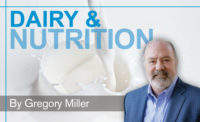The food matrix presents opportunities for dairy
The interplay of essential nutrients and bioactive compounds in foods impacts their potential health and wellness contributions.

The food matrix — the emerging concept of looking at the whole food’s nutrient and non-nutrient components and their molecular relationships — presents exciting opportunities for dairy.
The food matrix comprises nutritional and physical aspects, which work together to affect nutrient digestion, absorption and metabolism. It’s like having every part of an orchestra playing together and in harmony. This comprehensive context can better reflect a food’s true nutritional value and health benefits. This complex interplay also may explain why nutrient supplements don’t always impart the same benefits on chronic disease risk as to the foods in which they’re found.
Understanding the dairy matrix
The possibilities are many when we consider the dairy matrix. For decades, nutrition science has championed the importance of essential nutrients in isolation. But it has become increasingly clear that it’s important to consider how the interplay of essential nutrients and bioactive compounds in foods impacts their potential health and wellness contributions.
The Office of Disease Prevention and Health Promotion defines bioactives as constituents in foods, other than those to meet basic nutritional needs, that are responsible for a change in human health. These components of milk have long been a subject of research investigation for the National Dairy Council, and others also are taking a deeper dive. In 2016, a team of 18 international nutrition researchers came together to explore the current evidence of the dairy matrix. Their results were published in the American Journal of Clinical Nutrition.
Milk’s physical matrix — 87% water and 13% solids — makes its structure similar to a series of compartments that enable unique interactions among carbohydrates, proteins, and fats. Milkfat is the most complex of all naturally occurring fats, containing more than 400 types of fatty acids. Milk also is known as one of the highest-quality protein foods, as it provides all nine essential amino acids.
But when the physical matrix of milk is transformed by fermentation, heat, and other ripening processes — such as when cheese and yogurt are created — the newly created foods possess their own unique physical and nutritional matrices. Cheese and yogurt can contain live microbes and active cultures, which have the potential to naturally produce additional bioactives such as peptides and short-chain fatty acids.
The dairy matrix and the unique interaction and contribution between nutritive and non-nutritive components may help explain why dairy is associated with positive health outcomes such as reduced risk of cardiovascular disease, type 2 diabetes, and hypertension. Dairy’s complex interaction of nutrients and bioactive compounds, along with the physical-chemical structure of milk, are what make it unique, especially in yogurt and cheese.
As the matrix continues to be understood, more opportunities will emerge to support what we have known all along: Dairy as part of healthy eating patterns is a versatile nutrition and wellness powerhouse!
Gregory Miller, Ph.D., is global chief science officer for the National Dairy Council.
Looking for a reprint of this article?
From high-res PDFs to custom plaques, order your copy today!





